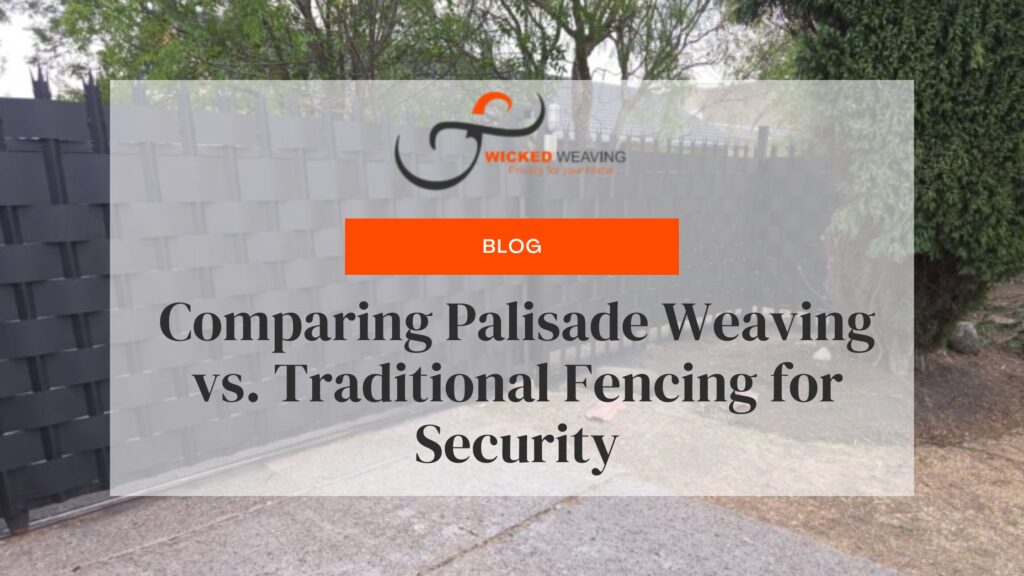When it comes to securing your property, the type of fencing you choose can make a significant difference. Both palisade weaving and traditional fencing options offer security, but each has unique advantages and applications. Whether you’re looking to protect a home, business, or industrial site, understanding the strengths and limitations of each type can help you make an informed decision.
- Strength and Durability
Palisade Weaving: Palisade weaving is known for its strength, as it involves interwoven steel strips through a palisade fence structure. This design enhances the fence’s resilience against physical force. The galvanized steel used in palisade weaving is resistant to rust and corrosion, ensuring it stands strong against weather elements and potential tampering. It’s an ideal choice for those prioritising long-term durability.
Traditional Fencing: Traditional fencing, which includes wood, vinyl, or chain-link, varies in durability based on the material. Wooden fences, while aesthetically pleasing, can wear down over time, especially in harsh weather conditions. Vinyl is more durable than wood but is not as strong as steel, and chain-link fences may rust if not properly treated. Traditional fencing may require more frequent maintenance and repairs to maintain its security levels.
- Anti-Climb Security
Palisade Weaving: Palisade weaving adds an anti-climb feature due to its vertical, pointed pale structure and close-knit design. This layout discourages intruders from scaling the fence, as it provides little to no handhold, making it ideal for high-security areas. Palisade fences can also be designed with additional deterrents like spiked tops, further preventing trespassing attempts.
Traditional Fencing: Traditional fences vary widely in climbability. Chain-link fences, for instance, offer footholds, making them easier to climb without additional anti-climb measures. Wood and vinyl fences are often taller and more challenging to scale but can be vulnerable to climbing if not adequately designed. Adding spikes or barbed wire can improve anti-climb capabilities, but these may detract from the fence’s aesthetic appeal.
- Visibility and Surveillance
Palisade Weaving: A key benefit of palisade weaving is its open, see-through design, which allows for easy surveillance. The spacing between pales lets property owners monitor their surroundings, enabling security personnel or cameras to keep an eye on potential threats. This visibility also acts as a deterrent, as intruders are less likely to approach an area they know is easily monitored.
Traditional Fencing: Solid traditional fences, such as wood or vinyl, block visibility, which can create blind spots for security teams or surveillance cameras. While this offers a higher level of privacy, it may also reduce the ability to monitor activities outside the fence. Chain-link fences provide some visibility, but their aesthetics and security level are typically lower than palisade weaving.
- Maintenance and Longevity
Palisade Weaving: Due to its galvanized steel construction, palisade weaving requires minimal maintenance. It is resistant to rust and corrosion, which means it can withstand extreme weather conditions without losing its structural integrity. Occasional cleaning and inspections are usually enough to keep it in excellent condition for many years, making it a cost-effective choice over time.
Traditional Fencing: Maintenance needs for traditional fencing vary significantly. Wood requires regular painting, staining, and sealing to prevent rot, while vinyl can become discoloured over time and may crack in extreme weather. Chain-link fences may need rust treatment and repairs to damaged links. Overall, traditional fences often require more frequent maintenance and can be more costly in the long run.
- Cost-Effectiveness
Palisade Weaving: Although palisade weaving may have a higher upfront cost compared to some traditional fencing materials, its long-term durability and low maintenance make it a cost-effective option over time. The enhanced security features, such as anti-climb design and visibility, offer added value, especially for high-security applications where reliable protection is a priority.
Traditional Fencing: Traditional fences like wood or chain-link may be cheaper to install initially, but their maintenance costs can add up over time. Repairs, repainting, or replacement of worn-out sections may be necessary, increasing the overall cost of ownership. For properties with moderate security needs, traditional fencing might be an adequate choice, but it may not offer the best value for high-security requirements.
- Aesthetic Appeal
Palisade Weaving: Palisade weaving provides a unique aesthetic that combines security with an industrial, modern look. It can blend seamlessly with both residential and commercial properties and is available in various colours and finishes to match your property’s exterior.
Traditional Fencing: Traditional fencing offers a broader range of styles, from rustic wooden fences to modern vinyl options, making it versatile for various aesthetic preferences. However, certain traditional designs may lack the high-security appearance, which may be a consideration for properties prioritising visible deterrents.
Conclusion
Choosing between palisade weaving and traditional fencing ultimately depends on your specific needs for security, durability, and appearance. For high-security properties or those seeking minimal maintenance with a modern look, palisade weaving is an excellent choice, offering strength, anti-climb features, and visibility. On the other hand, traditional fencing may be sufficient for properties with moderate security requirements and offers a variety of aesthetic options.
At Wicked Weaving, we specialise in providing top-notch palisade weaving solutions designed to secure your property for years to come. Contact us to learn more about our fencing options and discover how we can enhance the security and aesthetic appeal of your space.

